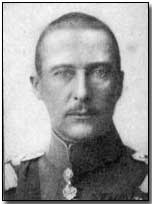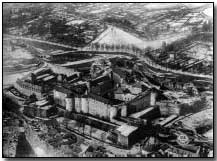Battles - The Battle of the Ardennes, 1914
 Fought between 21-23 August 1914, the Battle of the Ardennes comprised one of the
Battles of the Frontiers conducted during the first month of the war, August 1914.
Fought between 21-23 August 1914, the Battle of the Ardennes comprised one of the
Battles of the Frontiers conducted during the first month of the war, August 1914.
The battle was sparked somewhat unusually by the mutual confused collision of French and German invasion forces in the lower Ardennes forests.
According to the pre-war French war strategy document, Plan XVII, German forces in the area were only expected to be light, with French light, rapid-firing. artillery proving advantageous in a wooded terrain such as that found in the Ardennes.
By 20 August however it was becoming apparent - first to General Lanrezac's French Fifth Army, and then to Commander-in-Chief Joseph Joffre - that a massive German presence was gathering in the area That same day the Germans launched a counter-offensive against the French advance into Lorraine Even so, Joffre authorised an invasion of the Ardennes on 20 August for the following day.
Two sets of armies joined battle on both French and German sides General Pierre Ruffey's Third Army and, further north, General Fernand de Langle de Cary's Fourth Army, fought the German Fourth and Fifth Armies: the former led by Duke Albrecht, the latter by Crown Prince Wilhelm The two German armies together formed the centre of the German Schlieffen Plan's advance into France.
The French Fifth Army, meanwhile, had been despatched northwards to Charleroi on the back of news of a German build-up of strength in Belgium.
German troops had begun to advance through the woods on 19 August, constructing defensive positions as they went Crown Prince Wilhelm was situated at Briey with Duke Albrecht en route to Neufchateau.
The aim of the advancing French forces was straightforward: to attack the German centre in the flank as it passed through the woods of the Ardennes.
 With the descent of thick fog the
opposing forces literally stumbled into each other in the woods on 21
August; in such fog, advance reconnaissance was of little worth At
this early stage the French mistook the German presence for small screening
forces; in reality the French were heavily outnumbered The first day
of the battle, 21 August, was marked by scattered fighting, mostly
skirmishes Widespread battle only began the following day.
With the descent of thick fog the
opposing forces literally stumbled into each other in the woods on 21
August; in such fog, advance reconnaissance was of little worth At
this early stage the French mistook the German presence for small screening
forces; in reality the French were heavily outnumbered The first day
of the battle, 21 August, was marked by scattered fighting, mostly
skirmishes Widespread battle only began the following day.
Superior tactical positioning by the Germans more than offset the occasional French success, e.g. at Virton, although casualties were heavy on both sides French troops, dressed brightly, were notably conspicuous in the woods, no concession to camouflage having been considered.
The French, acting with 'offensive spirit', charged at German positions in the wood, only to be cut down by efficient machine gun fire, backed by heavy artillery.
 In contrast to the Germans' willingness
to settle and dig trenches, the French forces began a disorderly retreat on
the late afternoon of 23 August, the Third Army withdrawing to Verdun chased
by the German Fifth Army (where Ruffey was subsequently removed by Joffre),
and Fourth Army retreating near Sedan and Stenay The latter engaged
their German pursuers whilst there on 26-28 August, temporarily halting the
Germans' progress.
In contrast to the Germans' willingness
to settle and dig trenches, the French forces began a disorderly retreat on
the late afternoon of 23 August, the Third Army withdrawing to Verdun chased
by the German Fifth Army (where Ruffey was subsequently removed by Joffre),
and Fourth Army retreating near Sedan and Stenay The latter engaged
their German pursuers whilst there on 26-28 August, temporarily halting the
Germans' progress.
As a consequence of the poorly managed French retreat the Germans were able to take possession of important iron resources, and were able to continue their advance into France.
The scale of the French defeat was notable, only becoming clear to Joffre after a period of time had elapsed. Even then he was inclined to blame the poor performance of his forces rather than attribute it to strategy and circumstances It did not dissuade him from planning further offensive attacks in the near future.
Click here to view a map of the Battle of the Frontiers.
Photograph courtesy of Photos of the Great War website
"Gas Bag" was a slang term for airships
- Did you know?
